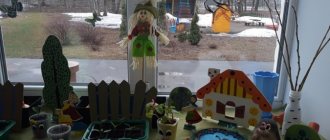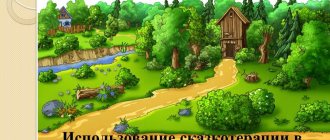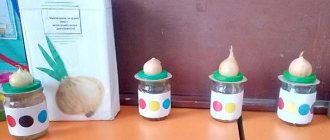Caring for indoor plants
GCD for joint activities with children to organize children's work in nature.
Topic
: “Taking care of indoor plants.”
Target:
Create conditions for consolidating children's knowledge about indoor plants of the group: their names, distinctive features of appearance and techniques for caring for them.
Tasks:
*to help consolidate children’s knowledge about indoor plants of the group: their names, distinctive features of appearance and methods of caring for them using symbols;
* promote the development of the ability to care for plants, using a labor process model for this: set a goal (help the plant so that it feels good again); choose an object of labor (a plant with drooping leaves, the ground is dry, gray, select tools and material; perform labor actions in the correct sequence (hold the watering can with both hands, place the spout on the edge of the pot, pour over the entire ground, little by little, wait until the water is absorbed and will appear on the pallet); get the result (a watered plant that will soon feel good);
* promote the development of a desire to take care of indoor plants, an understanding of the need to help a living being.
Materials used in the lesson:
Demonstration - schematic models - cards with symbols of plant care techniques, operational cards.
Distribution - Aprons for each child, tools: rags for each child, a basin with water, watering cans with water, sticks for loosening the soil, oilcloths, a sprayer.
Enrich your vocabulary with the following words: plant care, watering, pan, settled water, lump of earth; fix the names of the plants: clivia, balsam.
Preliminary work.
Observation of a plant (familiarity with the features of appearance, structure, observation of plants in favorable and unfavorable conditions (lack of moisture, a series of experiments to identify the moisture needs of plants, observation of the work of a teacher in watering plants in a corner of nature (familiarity with the model of the labor process).
Methodical techniques:
1. Problematic situation with the use of a game character.
2. Talk with children about the basic needs of indoor plants.
3. Examination of plants to identify distinctive features of appearance and methods of caring for them, using symbols.
4. Organization of the labor process using models - operational maps.
5. Joint work of children, help from the teacher.
6. Summing up the results of joint activities.
Progress of joint activities with children.
1 part
Carlson's game character arrives, sad (he flew into an open window while ventilating during nap time). Says hello to every child.
Educator. Our Carlson is somehow sad. Let's ask him what happened.
Carlson. He tells his story of how he flew past the garden and saw such beautiful and well-groomed flowers on the windowsills outside the windows. With him on the roof lives his only flower, which was given to him by his friend Baby, but something happened to him, he probably got sick.
My favorite plant was as beautiful as in the picture (model shows)
and now it’s like this (shows the plant)
I don’t know what happened to it, I feel sorry for the plant, that’s why I’m crying.
Educator. Children, do you feel sorry for the plant? Let's take pity on him, tell him kind words: good, don't cry, we will help you, you will become beautiful and healthy again.
Educator. Why did Carlson's plant become like this? What do plants need to feel good? Listen to what the plant is asking for. Carlson, your plant needs to be looked after and it will get better.
Carlson. But I don’t know how to care for plants, and now my plant will probably die.
Educator. Can we help Carlson? How? (We can teach him how to care for plants.) Shall we teach Carlson how to properly care for plants? (We will;)
part 2
Educator. How do we want the plant to feel? (Okay.) So that it becomes what? (With the children they say: so that the plant feels good, so that the leaves look up, so that the stem looks up, so that the ground is moist.) In order not to forget about this, we will put a picture (the model is a plant in good condition)
Educator. What plant is it now? (The plant is being examined: the condition of the leaves, stem, soil.) In order not to forget what kind of plant it is now, we will put a picture (the model plant is in an unfavorable condition)
The plant needs help as soon as possible. What else do we need for this? To do this, you need to choose the right tools or assistant objects.
Carlson. I know what's needed. (Brings an empty watering can. The empty watering can is examined and why it cannot be used for watering is discussed.)
Educator. Which watering can should you take? Water is filled into the watering can in advance so that the water settles and is at room temperature. What other helper items do we need to help our plants? Children name the remaining objects. In order not to forget what we need, we will put a picture (model - tools: watering can with water, oilcloth, basin with water, rags, stick for loosening the soil, sprayer)
Now what are we going to do?
Children: And now we will take care of the plants.
Educator: Correct, but first, we must consider the plants we have chosen for care (Clivia and Impatiens) and determine what our plants love and what kind of care each one needs. And the cards that are glued to each pot of a houseplant will help us with this. (Plants are examined, the name of the plant, distinctive features of appearance are recalled, methods of caring for them are determined using symbols.)
Carlson: Well, now can we start caring for the plants?
Educator: Yes, but only for this, we need to remember where we start, because caring for a plant is not only watering it.
Children: First, we take care of the leaves of Clivia, we wipe the leaves, and we spray the leaves of balsam, then we wipe the pots, then we wash the trays, after that we loosen the soil in the pots and only lastly water the plants. (If children find it difficult to determine the sequence of methods for caring for plants or have forgotten something, draw the children’s attention to the operation cards)
Educator: Well done, guys, you clearly remembered all the steps to care for plants, now you can start working, but first everyone needs to put on their aprons and roll up their sleeves. Now we will distribute who will do what work, I will help you. (After distributing responsibilities, the children go to the table with tools and choose an assistant object for themselves) And you, Carlson, watch carefully and remember what the guys are doing.
Children perform tasks under the supervision of a teacher, the execution of actions goes as far as watering.
Carlson. I remembered how to water, can I show you? (Holds the watering can with one hand, pours water on the leaves, under the roots, wants to pour all the water out of the watering can at once.)
Educator. Why can't you water the leaves? Why do you need to water the soil? (Children explain and show how to water correctly.)
Educator. How much water will we pour?
Carlson. Until it's all over! (Children explain to hold the watering can with both hands, place the spout on the edge of the pot, pour it all over the ground, little by little, wait until the water is absorbed and appears on the tray. Children, focusing on the model of the labor process, independently water the plants
Carlson, together with the teacher, observes the children’s work, asks clarifying questions. In case of difficulties, the teacher comes to the children’s aid. At the end of the lesson, the teacher and the game character check how the children watered the plants.)
Educator. What will the plant become if we have cared for it properly? (Children explain.) In order not to forget, let’s put a picture (the model is a plant in good condition
drowning).
Part 3
Educator. Carlson, we helped your plant, taught you how to care for indoor plants, now it will get better. We showed you on some plants in our group how to care for plants, what conditions are required for different plants and what care is needed to make them look like in the picture. (Shows a model - the plant is in good condition.) Educator. Soon our plants will become as beautiful and healthy as in the picture. (Shows the model a plant in a favorable condition.) They will feel good. Today we did two good deeds: we helped the plants (listen to what they tell you) and taught Carlson how to care for his plant.
Carlson. Thank you guys, now my plant will always feel good. I'm very happy about this.
Educator. Guys, are you glad that you helped the plants? (Emotionally share the joy of the children.) Let's give Carlson this flower in memory of us - Clivia, so that his flower will have more fun, so that he is not alone. And you, Carlson, don’t forget to take care of your plants and come visit us again! Goodbye! .
Follow up work:
Continue:
1. to form a conscious attitude towards work, ways to achieve the goal with the help of operational cards;
2. develop the perception of indoor plants as living beings - notice their unfavorable state, discover the insufficiency of conditions for their life in the process of observations in everyday life, using “Models of the functions of living organs”, D/ games “Confusion”.
3. cultivate interest and love for plants, the desire to care for them both in specially organized classes and in joint activities with children
Walk “Observing flowers in a flowerbed”
Walk “Observing flowers in a flowerbed”
Goal: Educational: - to form an idea of the diversity of inanimate nature; - learn to admire growing flowers. Developmental: —
develop the ability to generalize based on essential features;
- develop speech, activate vocabulary; - expand your understanding of plant parts. Educational: -
cultivate a responsible attitude towards nature;
- cultivate a caring attitude towards the beautiful creations of nature. Progress of the walk. Mystery.
The meadow is just like a chintz scarf of all colors - You won’t understand where the butterfly is, Where the living flower is. Forest and field in greenery, blue river, White, fluffy clouds in the sky.
Children.
In summer.
Educator.
- Guys, today I invite you to take a walk and look at our flower beds. (Children go to the flower beds.)
Listen to the poem.
I walk through a green meadow, the dew dries on the leaves, the wind sways the grass elastically, and I hear the voices of flowers. They whisper: “Don’t tear us, don’t, don’t crush our flexible stems. We are a delight for the eyes and the heart, an adornment of our native land.”
Educator.
- Guys, listen to the riddle.
Mystery .
The leaves bend in a spiral, And huddle together, And above them are those flowers, Not buds, but perfumes, What kind of flowers are these?
Children.
Lily (Invite the children to look at the flowers and remember the names.)
Because of their long stems, lilies are always planted inside the flower bed so that the flowers look beautiful among the shorter flowers at the periphery of the flower bed. The lily has a lot of lanceolate leaves, collected in a basal rosette, from which emerges a tall straight stem with an elegant flower. Lily flowers are orange, snow-white, tiger (speckled with black spots), etc. The root of the lily is a bulb. On a large lily flower it is very good to see the parts of the flower. The larger the flower, the better its parts are visible: the petals of the corolla, located on the receptacle, are large and orange; large black stamens with pollen sacs at the tips; in the middle there is one tall pestle.
Find identical flowers (lilies and petunias) and flowers collected in inflorescences. (Children find flowers).
Educator.
Listen to the riddle and say “What flower are we talking about?”
Mystery.
We bloom alone, summer
And we decorate the garden.
We look like velvet
Everyone will be happy to see us. (Marigold.)
Consider the differences between these colors.
Educator
.
All flowers are pleasing to the eye and decorate the surrounding space. Let's remember the poems.
1. We will water all the flowers on a hot, clear summer day. We will take care of the flowers so that they always bloom.
2. In spring and summer, here and there, flowers bloom to the joy of everyone: In the forest, in the field - wild, Fragrant, beautiful, alive. That's why I don't pick flowers. And you?
Didactic game “Flowers Shop”
Purpose:
to teach how to group plants according to their place of growth and describe their appearance.
Progress of the game.
Children play the roles of sellers and buyers. To make a purchase, you need to describe the plant you have chosen, but not name it, just say where it grows. The seller must guess what kind of flower it is, name it and the department of the store in which it is located (field, garden, indoor), then issue the purchase.
Educator.
- Guys, let's remember the signs. 1. Before the rain, roses and marigolds do not open their flowers. 2. By 8 o’clock in the morning, marigolds open their inflorescences. 3. Marigolds do not open their flowers - it means rain.
Experiment “Plant water requirements”
Children approach the flowerbed and pay attention to the condition of the flowers. Those flowers in flower beds that have not been watered for several days look drooping, the leaves are lowered to the ground. Those who watered stand with their heads held high.
Outdoor game “Developing attention” Purpose
: develop attention.
Progress of the game.
I suggest the children look around them (5-10 seconds) and remember as many colors as possible in order. Then blindfold. Swap the flower and ask them to list it in order as it was.
What changed?
Conclusion:
plants need water.
Labor on site
. Watering the flower beds.
Educator.
It's time for us to return to the group. — What new did you learn today?







